Test Parameters
Ammo
Results
Conclusion
Fiocchi 40-grain VMax

Due to the limited number of wall sections available, it made sense to start with the round that seemed likely to penetrate the least number of walls: The zippy, light, and thin-jacketed V-Max ammo.
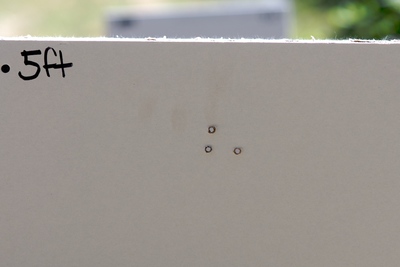
The hypothesis turned out to be correct: V-Max bullets started fragmenting within the first sheet of drywall and completely blew to pieces on their way out of the second sheet, leaving dramatic craters.

Most of the rounds had fragmented by the time they reached the second wall. A couple roughly circular holes suggest that some of the rounds were more intact than others when they hit the second wall. My bet is that these rounds didn't fragment as much in the first wall because they were shot so close to preceding rounds that they passed through the craters in the rear of the wall.
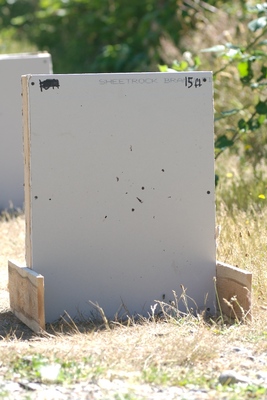
These were probably the rounds responsible for reaching the third wall, where they left small holes.
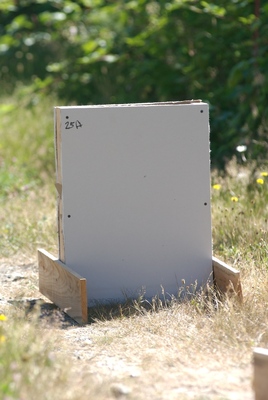
It's debatable whether rounds using V-Max projectiles are the ideal choice for defensive purposes, as ballistic gelatin tests show such bullets penetrating far less than the FBI's recommended minimum of twelve inches. However, this lack of penetration in gel works in their favor when dealing with wallboard.
Handgun Rounds
Every time there's a debate about the best firearm for home defense, someone inevitably chimes up to say that among his reasons for keeping a handgun for this purpose is the fact that handgun bullets won't go through as many walls as rifle rounds.
As a categorical statement, this is completely incorrect. Here's proof. First, some .45 ACP.
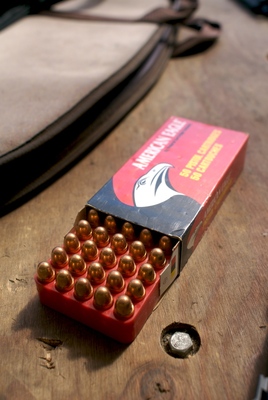
It's said "they all fall to hardball;" apparently this includes walls, because the bullets sailed through all three walls without showing any sign of slowing, tumbling, or deforming.
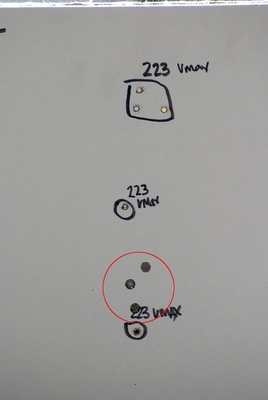
.45 ACP FMJ, Wall 1
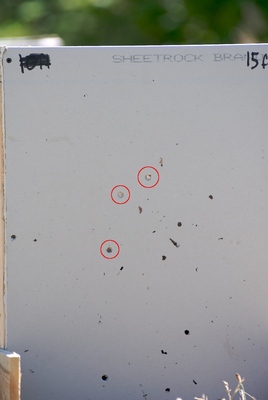
.45 ACP FMJ, Wall 2
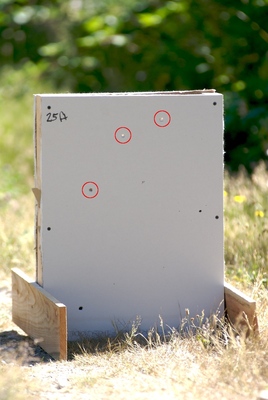
.45 ACP FMJ, Wall 3
Law enforcement in the 1920s discovered that .45 ACP didn't like to go through heavy metal car doors and switched to the high-velocity .38 Super. If the car doors had been made of gypsum, it wouldn't have been an issue. But that raises a question: Will there be any significant difference in penetration between .45 ACP FMJ and 9mm JHP?
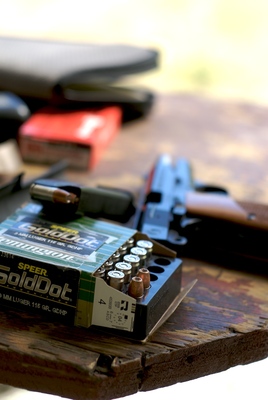
9mm jacketed hollowpoints (115-grain Speer Gold Dots, to be precise) didn't fare much better:
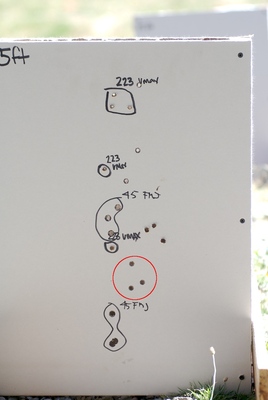
9mm Speer Gold Dot, 115 grain, Wall 1
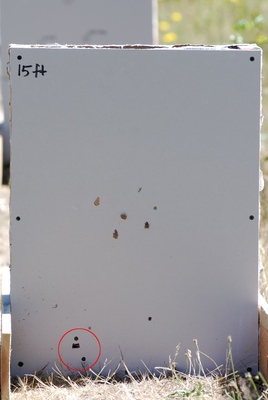
9mm Speer Gold Dot, 115 grain, Wall 2
Misalignment of the shots on my part prevented any rounds from reaching the third wall. Retesting was planned, but abandoned after we saw what the diametrically similar but ballistically inferior .380 rounds did.

The only handgun round that failed to consistently penetrate all three walls was .380 ACP, represented here by Magtech FMJ. All three rounds went through the first wall.
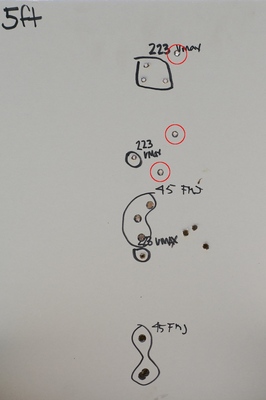
.380 FMJ, Wall 1
One round hit the dirt before the second wall, but the other two went through.
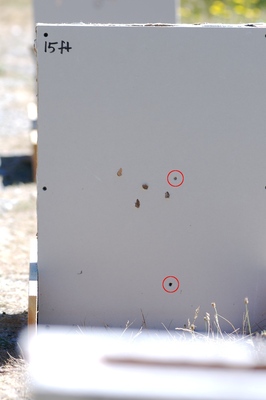
.380 FMJ, Wall 2
Only one round failed to have a close encounter of the ground type before reaching the third wall, but that one penetrated the first sheet of drywall and bounced off the back of the second.
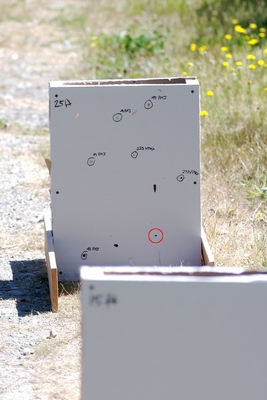
.380 FMJ, Wall 3
It's safe to say that there are better choices than handguns if wall penetration is a concern.
Wolf 7.62x39mm FMJ
In case you were wondering about those intriguing keyholes in some of the handgun photos, those come from one of the more surprising tests: Wolf 7.62x39mm 122-grain FMJ bullets fired from an AK.

7.62x39mm is not known for its fragmentation, especially in full metal jacket form, so it was expected that these rounds would punch neat holes through all three walls.
This was true for the first two walls:
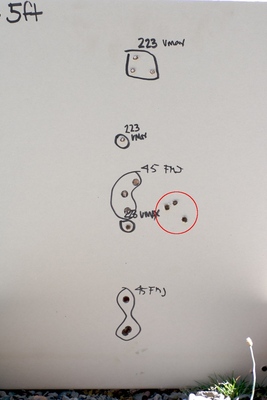
7.62x39mm, Wall 1
Two rounds went through the same hole; unusual for an AK.
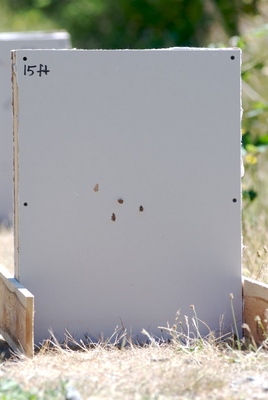
7.62x39mm, Wall 2
Note elongation of holes as tumbling begins.
Between the second and third wall, the bullets must have slowed enough to lose stabilization, because every round that managed to hit the wall was tumbling when it did. They still went through all the walls, but at least they made nifty-looking holes in the process.
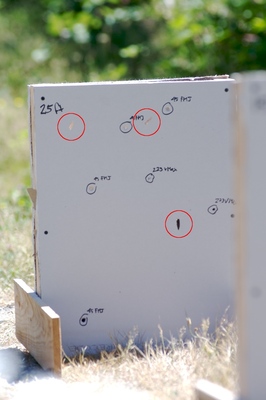
7.62x39mm, Wall 3
Winchester Ranger 55-grain Softpoint
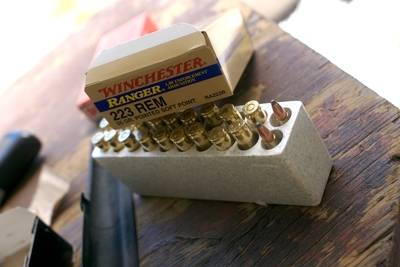
Because we'd been punching clean holes through the boards, it seemed logical to make the most of the relatively clean second wall by choosing a round from which we didn't expect a great deal of expansion: Winchester Ranger 55-grain softpoints. I'm not sure why we thought these rounds would hold together through all the walls, because it sure seems like a silly assumption given what happened.
The first rounds provided the ubiquitous clean holes through the first wall.

Winchester Ranger 55-grain Softpoints, Wall 1
But only chunks hit the second wall. These were larger fragments than the V-Max bullet produced, and several of them penetrated the second wall, continuing on to the third.

Winchester Ranger 55-grain Softpoints, Wall 2
Preexisting holes digitally removed; click here for original.
Only one fragment appeared to make it through the first of the drywall sheets in the final wall; the rest just left tiny speckles.
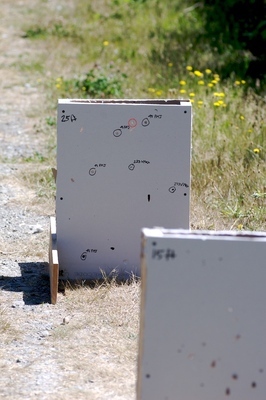
Winchester Ranger 55-grain Softpoints, Wall 3
Hornady TAP 55-grain
Given that the first two .223 rounds had blown to pieces in the first section of simulated wall, we had similar expectations for the TAP fitted with the 55-grain ballistic-tip bullet.
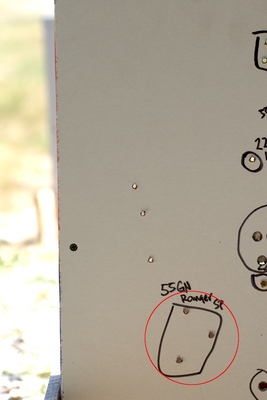
Hornady TAP 55-grain, Wall 1
Note: Group is mislabeled in photo.
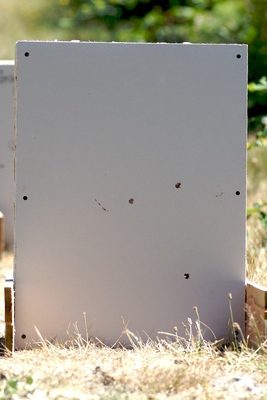
Hornady TAP 55-grain, Wall 2

Hornady TAP 55-grain, Wall 3
Upper-right hole mislabeled.
Although Hornady's website shows impressive fragmentation in ballistic gel, this same behavior was notably absent from the bullets in drywall. All three rounds tested drilled neat holes through every single wall. Either the polymer tip is clearly intended to aid external ballistics more than terminal ballistics, or its performance in drywall isn't representative of its behavior in moister media. The latter is most likely the case, given the published gel results.
Hornady 60-grain TAP
The effect of 55-grain TAP was so contrary to expectation that it demanded immediate investigation of how the slightly heftier 60-grain equivalent performed. The results here were, if anything, even more surprising.
As usual, the entry holes were neat and tidy.
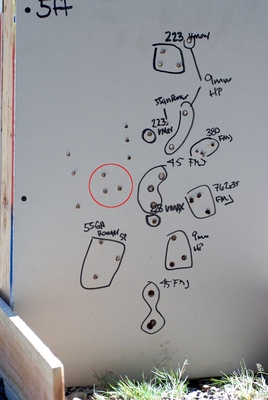
But the second wall showed exactly two holes per bullet, with very consistent spacing between the holes from shot to shot. The bullets fragmented into two pieces in a very repeatable manner, perhaps snapping at the cannelure.
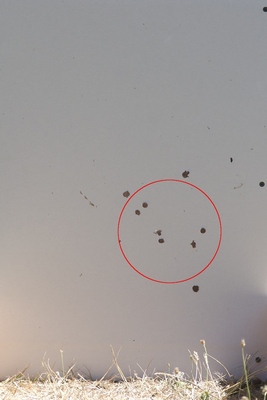
By the third wall, consistency in spacing, size, and penetration had vanished. This is to be expected if dealing with tumbling, irregular chunks of bullet that have had multiple sheets of drywall to throw off their surprisingly predictable fragmentation pattern. However, the fragments that struck this wall appear to cluster into locations rougly corresponding to the spacing observed in the other two walls.
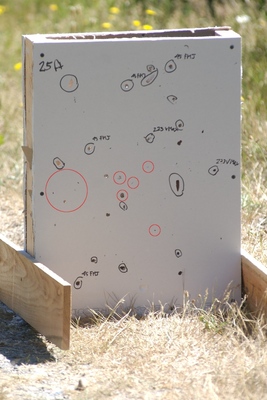
Winchester Ranger 64-grain Power-Point
Finishing off the .223 ammo selection was a return to Winchester Ranger softpoints, this time with a heavier bullet.
The first wall showed yet another set of identical entry holes.
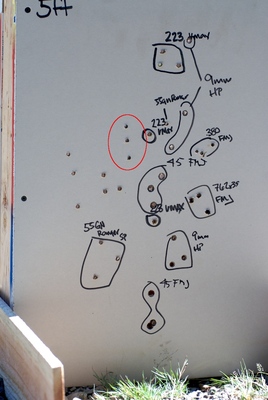
The second wall showed impacts similar to what was seen with the lighter Rangers, but with less consistency in size. In addition to the tiny spatters from small fragments, several fragments were large enough to punch through at least the first sheet of drywall.
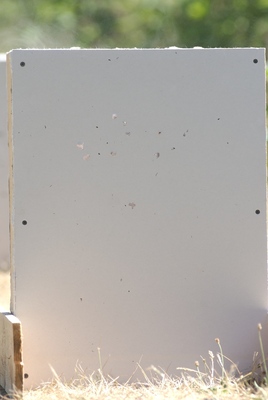
Preexisting holes digitally removed; click here for original.
It didn't look like they made it through the second wall, though, as there were no new marks on the third. The heavier weight and ostensibly different bullet construction ("Power-Point" vs. "Pointed Soft Point") didn't seem to make much difference where the walls were concerned.
Winchester 12-Gauge 00 Buckshot
Of course, no internal wall penetration test would be complete without including some good old-fashioned 00 Buck. We saved this one for last on the assumption that it would destroy entire sets of walls. This assumption turned out to be completely correct.
From five feet, the damage wasn't too bad. All the shot pellets clustered into a single hole just large enough to put a finger through.
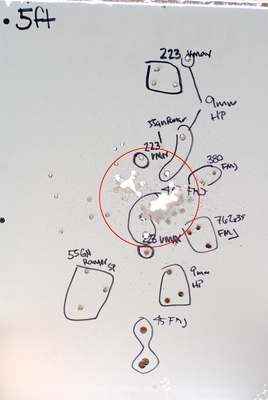
Not only had the shot spread out quite a bit by the time it reached the second wall, but it didn't slow down much at all. It left a healthy spatter of neat round holes through both sides.
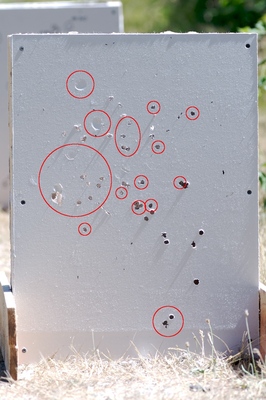
Note dents from shot cups.
This trend continued in--and through--the final wall. If buckshot is supposed to limit penetration through interior walls, it does so only at a theoretical level.
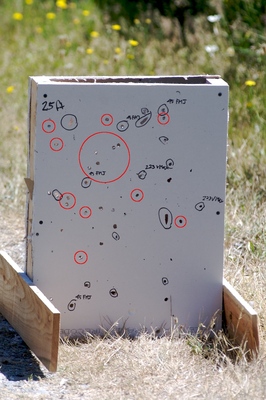
Summary
| Ammunition | Wall 1 | Wall 2 | Wall 3 |
|---|---|---|---|
| Fiocchi 40-grain VMax | penetrated | fragments, some penetration | few speckles, no penetration |
| Federal 230-grain .45 ACP FMJ | penetrated | penetrated | penetrated |
| Speer 115-grain 9mm Gold Dot JHP | penetrated | penetrated | missed (user error) |
| Magtech 90-grain .380 FMJ | penetrated | penetrated | penetrated first wall |
| Wolf 7.62x39mm FMJ | penetrated | penetrated | penetrated (keyholes) |
| Winchester Ranger 55-grain Softpoint | penetrated | fragments, some penetration | speckles, one fragment penetrated first wall |
| Hornady TAP 55-grain | penetrated | penetrated | penetrated |
| Hornady 60-grain TAP | penetrated | penetrated, two pieces | fragments, some penetration |
| Winchester Ranger 64-grain Power-Point | penetrated | fragments, no total penetration | no hits |
| Winchester 12-Gauge 00 Buckshot | penetrated | penetrated | penetrated |
All Photos © 2009 B. Toombs
email: hidi.projects at gmail.com